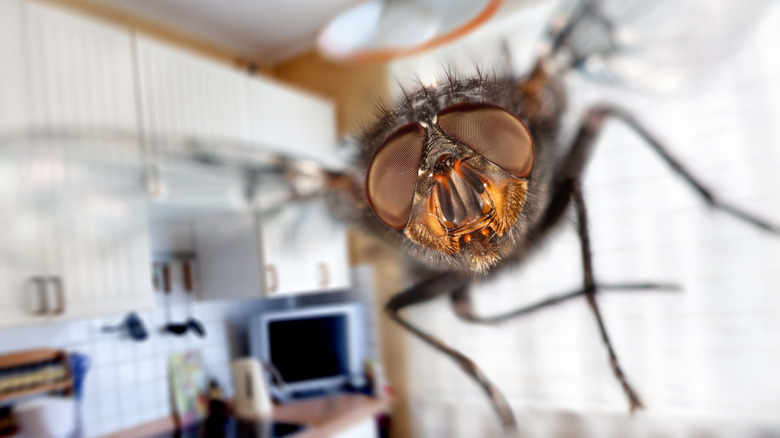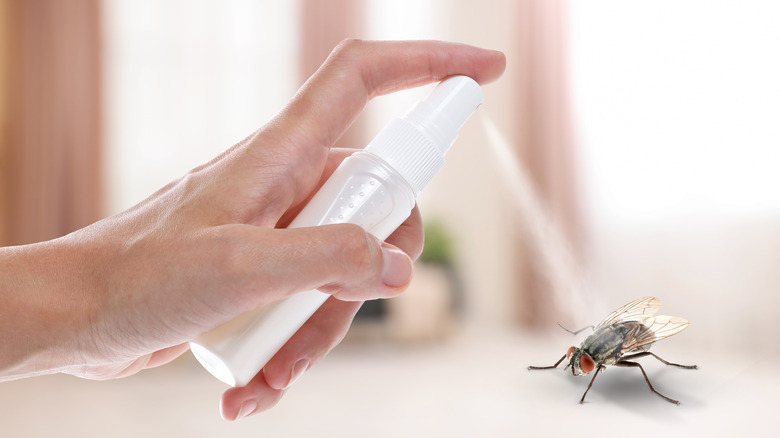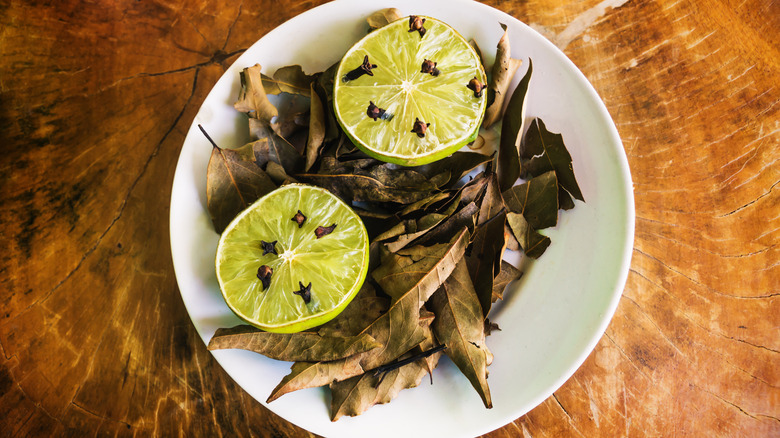How To Banish Flies From Your Home Naturally
Every time you open the door to your house, there's a chance that a fly (or two or three) will rush in before you can close it. The chances increase in humid and warm weather as flies become most active between late spring and early fall. Aside from wanting to get rid of the annoying buzz, it's important to address the presence of these insects before you see the signs of a housefly infestation — such as unusual odors, and the presence of larvae or maggots — because of the health risks. Fortunately, there's a natural way to do that: using essential oils.
Many insects find certain scents offensive, overwhelming their senses, so they won't go near them. When it comes to flies, thyme is one of the most effective scents at driving them away. Other scents that work well include bay, eucalyptus, lavender, and peppermint. It's easy to use essential oils from these plants to create a homemade spray that repels the flies, sending them on their way back out the door. To create a spray, all it takes is diluting the oil with water in a bottle. Then, spray around doors, windows, and any other entrances. If you notice flies gathering in a certain area of your home, consider soaking cotton balls with the mixture (or adding a few drops of the undiluted oil) and placing them in those areas to keep the flies away.
Benefits of using essential oils to get rid of flies in your home
One of the biggest benefits of using essential oils to repel flies is that they're natural and nontoxic, unlike many chemical sprays and pesticides. Even without the toxins, these oils still have insecticidal powers while remaining an eco-friendly option. A study published in Biocatalysis and Agricultural Biotechnology found that essential oils hinder the function of neurotransmitters in the central nervous systems of insects, while another study published in the Journal of Vector Ecology found that adult flies died after one hour of exposure to cinnamon and lavender essential oils.
Once the flies are out of your house, essential oils are a great way to keep them out of your house without killing them because they won't want to go near the smell. Why would you want to save flies, though? Believe it or not, houseflies have their benefits in the ecosystem, acting as a source of food for some animals. Additionally, if flies were to go extinct, the world would lose one of its decomposers and more biological waste may build up than usual.
On top of that, using essential oils to drive away flies will make your house smell delightful and more inviting, particularly scents like lavender and peppermint. They might be strong and unpleasant to the flies, but they can be refreshing and invigorating for humans, which is why they're often used in aromatherapy.
More natural ways to rid flies from your home
Essential oils are just one natural fly repellent you can use in your home. One option is to plant strong-smelling herbs that flies don't like — basil, lavender, mint, and rosemary — near your doors and windows. Another is to combine a citrus fruit with cloves. Simply cut an orange, lemon, or lime in half, and stick a few cloves into the flesh of each. Then, set the halves flesh side up on a plate or tray in each room of your house or in areas where the flies are most active.
If you want to go the extra mile, you can turn this combination into a diffuser in just a few steps to help the scent spread throughout the space. Cut off the top of a citrus fruit (about ⅓ of the height) and a small bit off the bottom so that it can stand upright on its own. With a knife, hollow out the middle of the fruit to place a short candlestick inside, and insert cloves into the fruit's flesh around that candle. Next, stick two long toothpicks on opposite sides of the candle so that you can place the top of the fruit over it, leaving enough room for the candle to light without being smothered. You'll start to smell the scent within seconds after lighting it, and while it will smell pleasant to you, the flies will want to escape.


